This is the fourth part in our series on how to build your own large solar generator. In this part we will be completing the wiring for the generator, including the solar charge controller, AC inverter, LED work lights, and USB outlets.
Main Battery Cables
There will be two sets of main battery cables for our generator. The first is the large set with pre-wired fuse that was included with our Kreiger inverter. The second set will be used to connect the battery to the solar charge controller, LED lights, USB / cigarette plug outlets, and AC trickle charger / battery maintainer. To do this it will run to a fuse block for load protecting all of these components. And finally, this second set of cables will also provide power to our high-current quick connector.
Note: We will want to make the actual connections to the battery last, as this reduce the risk of causing an electrical short.
In order to simplify the cabling, I placed the ground (-) bus bar, and fuse block between two 12″ battery cables. One end of these will lead to the battery, the other to our high-current quick connector. This eliminates the need to run a 3rd set of cables directly to the battery, and also helps to reduce the total length of high-current wire needed.
In order to determine the placement of the fuse block and negative bus bar, we need to connect the one set of cables to the high current quick connector first. To do this, snip the ring eyelet connectors off one end, and replace with the crimp connectors provided with our high current quick connector. I used a large set of crimpers for this, but you can also use a punch and a hammer to crimp the wire on these large connections. Once the connectors are crimped, they will lock into the quick connector body. Make sure you place the red wire on the side marked with the +.
Then using the ring eye connector on the other end of these cables, attach the other set of cables stacked onto the lug for our negative bus bar, and the lug for our fuse block. Refer to the picture for wire placement. We want to make sure these lugs are tightened nice and snug so that we have a good solid connection.
Now that we know how much cable we have to work with, determine the best place to mount the bus bar, and the fuse block. Once that is determined, mount them both firmly in place with the glue gun. Make sure to keep the battery disconnected as much as you can in order to reduce risk of an electrical short.
Wiring LED Work Lights
Both LED work lights will be wired to their power switch in the same way. We will start with the one mounted to the case cover, as it is the easiest to see the connections.
The first step is to bend the LED power wire over to the power switch, and cut to length while giving a small amount of extra slack. Then strip the insulation off the two power wires.
Now take the free end from your black wire spool and strip the insulation off that as well. We will be crimping this long black wire to share the same connector as the black wire from the LED work light. This will provide ground to both our LED work light, as well as the indicator light for the power switch. Its always a good idea to gently tug on your wires after crimping to make sure the connection is solid.
Now attach a second blade style crimp to the LED light’s red power wire. After that, take the free end of the red spool of wire and attach a third blade style crimp.
Looking closely at the blade connectors on the back of the switch, you will see one is brass colored. That is the ground connection, which is where we will attach the crimp sharing the two black wires. The middle terminal is for the load, which is where we will attach the red wire leading to the LED light. Finally, the third terminal is for the power source, which is where we will attach the long red wire coming from our spool.
Now route the two long wires from the spool down the inside of the cover, and then down along the edge of our case towards the fuse block and bus bar. Giving yourself some extra length to tidy the wiring later, cut both wires off the spool.
Follow these same steps to wire the other LED work light inside the case.
Wiring the 12V Battery Gauge, USB and Cigarette Plug Sockets
The three components of this pod all have separate blade connectors, but can be daisy-chained onto the same wire to reduce the total number of wires needed. We will also be wiring them into a power switch, just like we did the LED work lights.
We will start by taking the free end of the red wire spool, and attaching a blade crimp connector. Connect this to the source terminal of the power switch (the opposite side of the brass colored terminal). Route this wire neatly towards the fuse block, giving yourself some extra length and cut it from the spool.
Once again taking the free end of wire from the red spool, attach another crimp connector and attach it to the load (middle) terminal of the switch. If you look closely at the two blade terminals on each of the three round pods, you will see them labeled with a + and a –. We want to daisy chain this red wire to each of the ones marked with a +. To do this, bend a loop in the wire first towards one of them on the end. Make the loop tidy, but with enough slack that the wire wont be strained. Fold the wire in halve at this blade terminal, and repeat the process until you have marked the location (with folds) for each terminal. When you reach the final + marked blade terminal, you can cut the wire off the spool.
Snip your red wire at each fold, and strip the ends of each segment. Place the ends into crimp terminals, and crimp them snugly. When you are finished you should have a red wire with four connectors all attached to it. One will be for the switch, and the other three for the round pods. Attach them to the terminals like shown in the picture.
We now need to repeat this same process for the black ground wire. For this one, we can also include the long black wire to our bus bar in the daisy chain. When finished, it should look like this:
Wiring Fuse Block & Negative Bus Bar
We now have all of our components wired, with the exception that we need to connect them all to the fuse block and negative / ground bus bar.
Start by tidying the wires into a bundle, routed along the back of the case and towards our fuse block. Eventually every black wire will be connected to the bus bar, and every red wire will be connected to a terminal on the fuse block. It is helpful to use zip ties to keep wires in place as you go.
Lets connect the black wires first to get them out of the way. All of the connections on the bus bar are electrically connected together, so the placements do not matter. We can also place two wires into one eye ring crimp connector to leave us with extra space for future connections. When you are finished each black wire should be firmly attached to a screw on the bus bar.
For the red wires, each blade terminal is fused by the fuse holder adjacent to it. It may make sense to fuse both of the LED work lights together, so their respective red wires can share the same crimp if desired. I recommend connecting the remaining red wires each to their own fuse terminal.
Once the red wires are all connected as well, your wiring should look similar to this:
At this point we can now reconnect the battery cables to the battery, and insert our fuses. I used a 10A fuse for the combined LED work light circuit. A 30A fuse for the solar charge controller, and another 30A fuse for the combined 12V battery gauge, USB connectors, and cigarette socket module. And finally a 5A fuse for our AC battery maintainer / trickle charger. Here is how it looks with the fuses and cover installed:
At this point the internal case wiring is complete, and you can test the various components!
Assuming everything is working, the only remaining things to wire is our solar panel to its extension cable, and if desired some jumper cables to a high current quick connector.
Wiring the Solar Panel
Because the wire made specifically for roof top solar panel installations is much more expensive and thicker than needed for a single panel, I am instead using high quality 16 AWG speaker wire. In addition to being much cheaper, it has plenty of capacity for a 100 watt panel as well as the additional benefit of having both wires bonded together for neater coiling.
Connect the free end of the spool of speaker wire to the solar panel pig tail connections, using two butt-splice crimps. Make sure that the red speaker wire is connected to the pig tail marked with the + on the solar panel. After splicing the two wires, wrap them in electrical tape to provide some extra weather proofing and to provide strain relieve for these connections.
Then un-spool however much length you would like to have for your solar panel. Once you have the length of wire you would like to have for your solar panel, snip it from the spool.
Strip the insulation off the wires of this end, and install the male trailer plug connector. Make sure to connect the red wire to the center terminal, and the black wire to the pin labeled GD. Once the plug is assembled, the wire was not quite thick enough for the trailer plugs built in wire clamp to provide strain relief, so I added some glue from the glue gun to provide some additional strength to the connector.
Quick Connect Jumper Cables
A set of quick connect jumper cables is a nice addition to our solar generator that will allow for easily using the internal battery for jump starting vehicles, or connecting to other high current devices such as winches, etc.
To make them, snip the clamps off on end of the jumper cables. Then strip the insulation off each of the wires, and crimp the large connectors that came with the high current quick connector. Make sure the two crimps are rotated in the same direction as each other. Like before, if you do not have a specialty crimper for these large connections, you can use a hammer and a punch.
Insert the connector with the red wire into the quick connect body on the side marked with a +, so that it locks in place. Repeat with the black wire into the – side and that’s it!
Main Components for the Solar Generator
To see the full list of components used in this build, see Part 1 – How to Build a Large solar Generator
At this point the solar generator is fully functional and usable. In Part 5 we will be adding a plexiglass cover and several improvements to our solar generator.


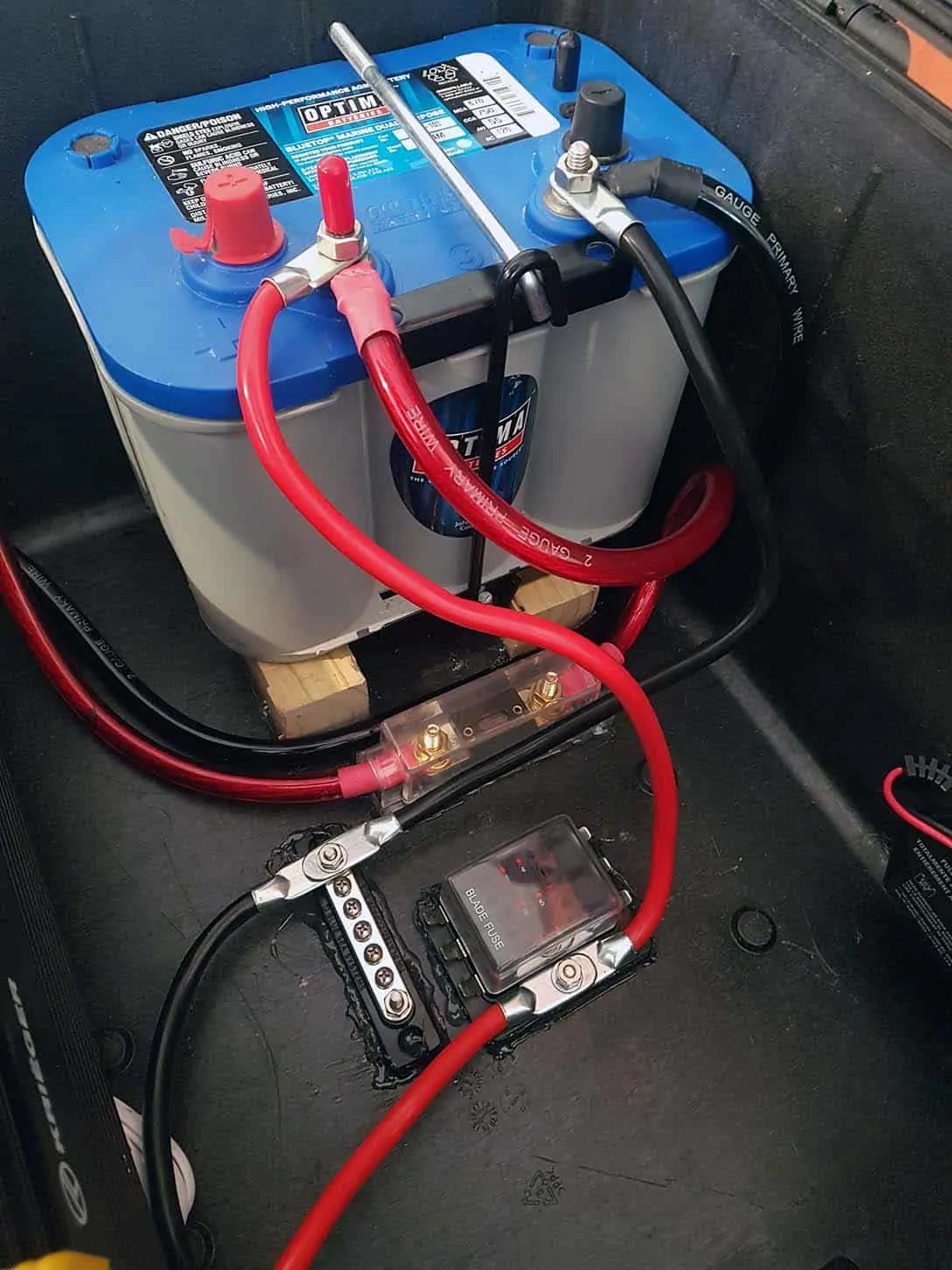



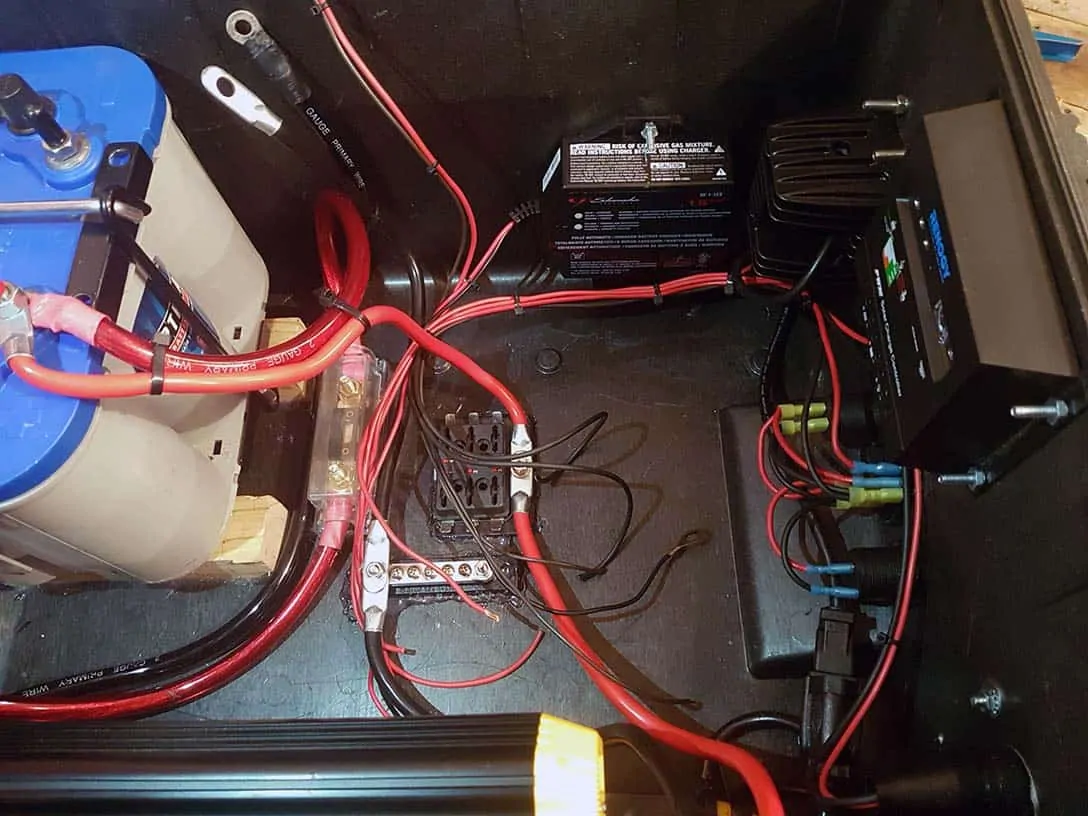
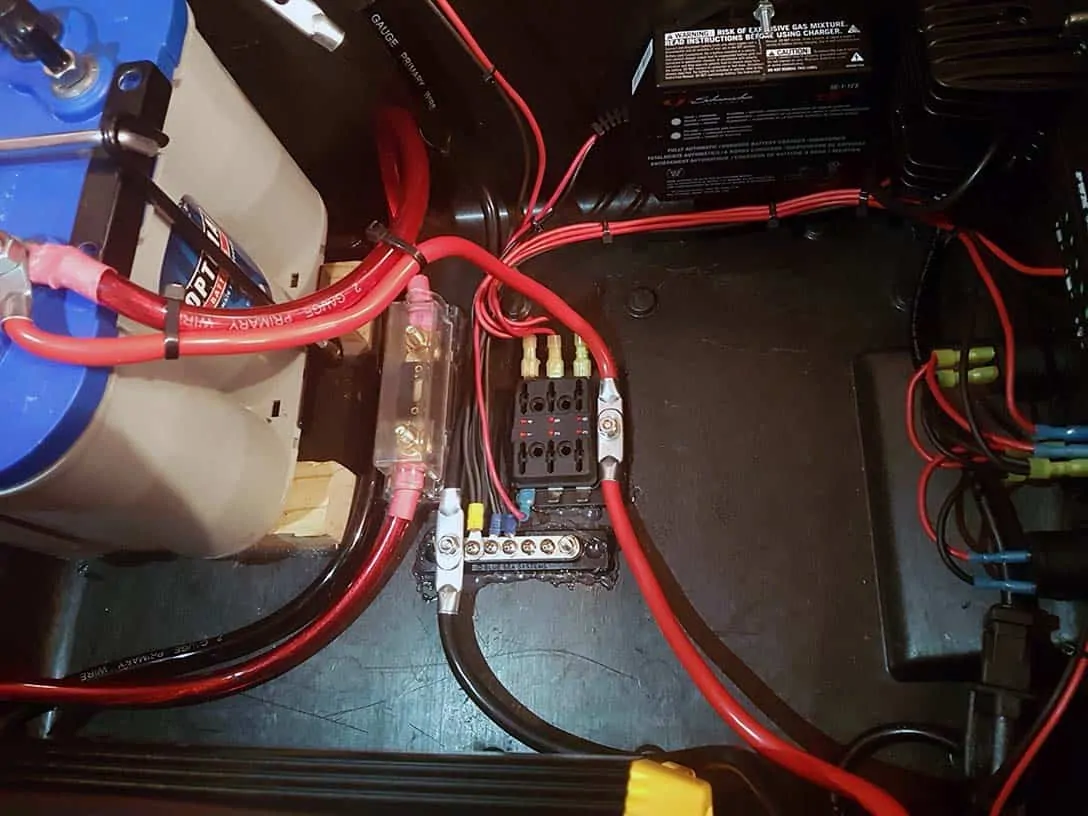

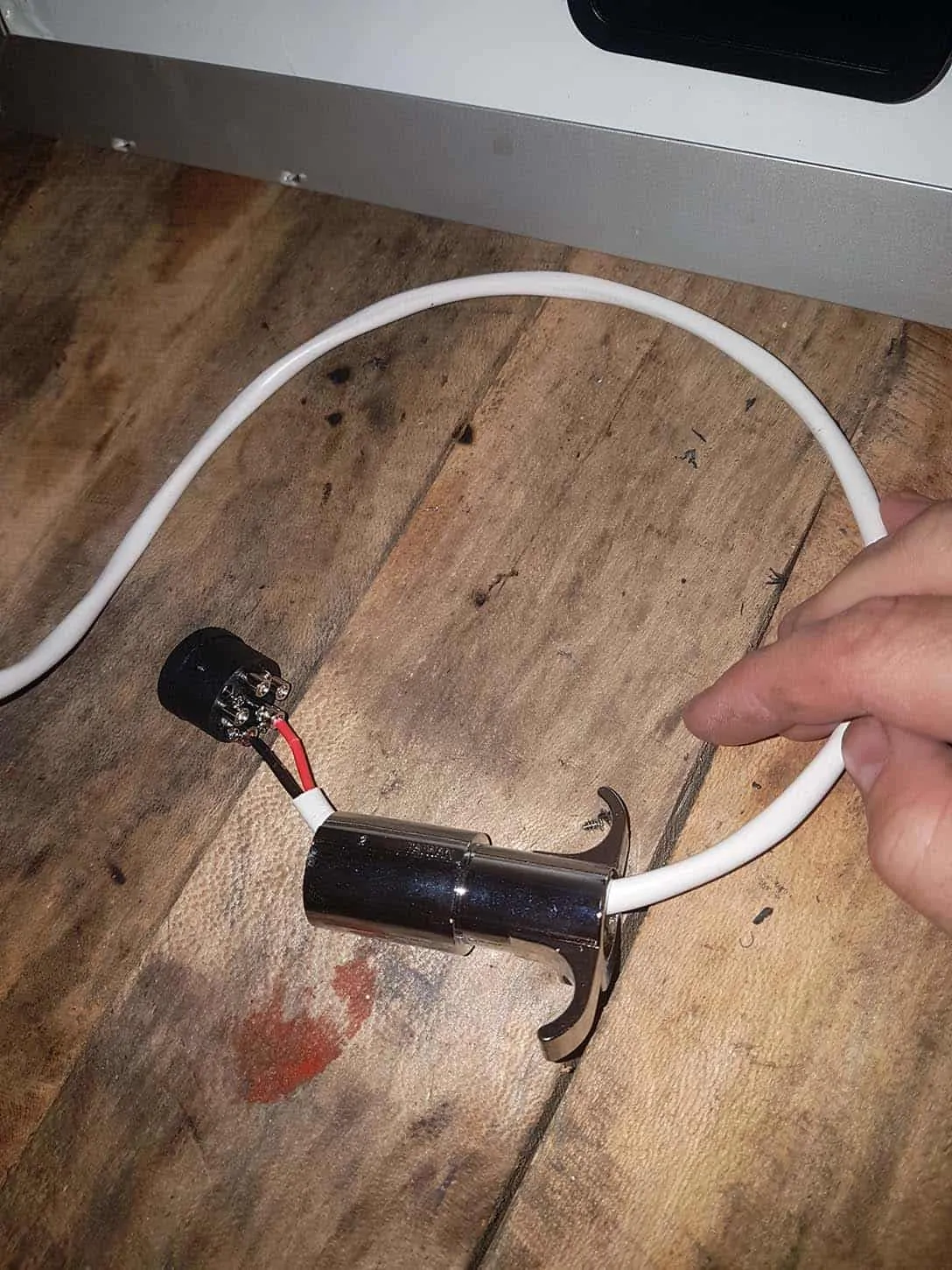
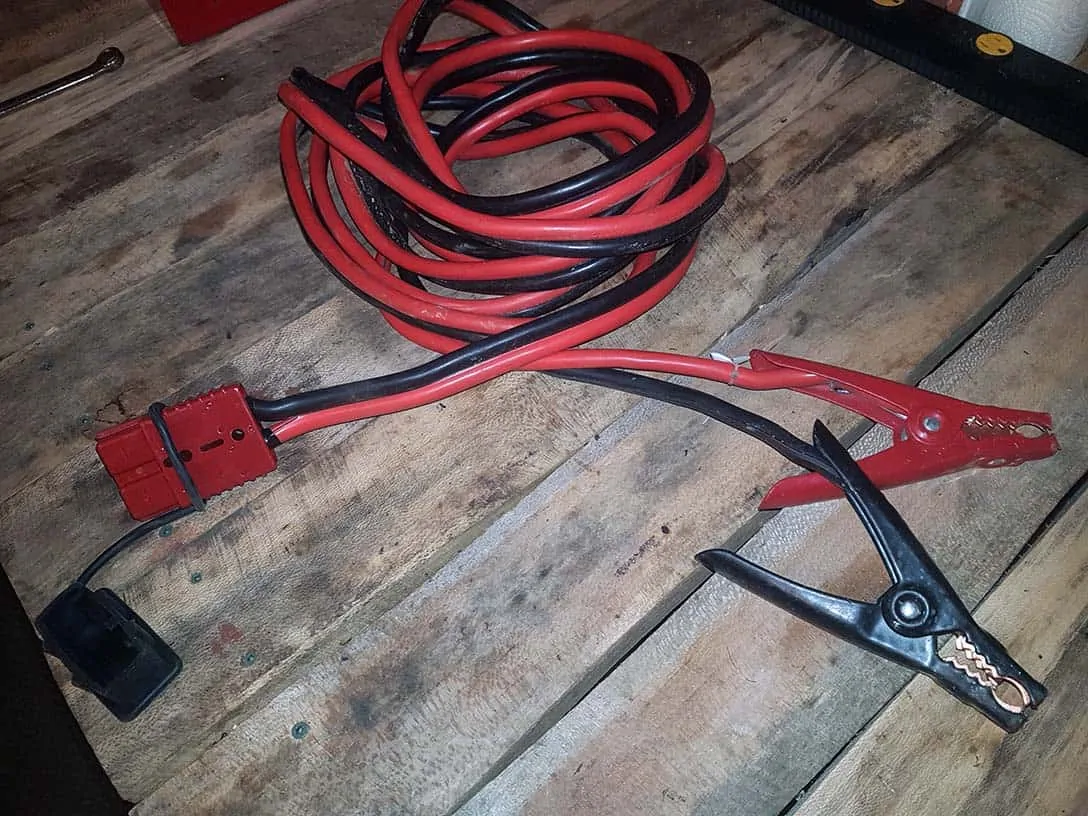
Did you post a wiring diagram? Can’t find it anywhere.
Hi James, I have had mixed feedback about the GFCI outlet. It seemed like a good idea to me because the unit is outdoors and possibly subject to moisture. Mine has been working without any issue, but some of the people have reported that the inverter manufacture has said that GFCI outlets are not compatible. I am a little confused at why this is, and many outdoor electric tools (such as electric power washers) have a GFCI built directly into their plug. I am not sure if this means that those tools are also not supported by the inverter as well?
I also had issues with the GFI. I ended up making two pig tails and plugging the male end to the outlets on the inverter. The other send I wired to the GFI. It locked in and works without issues. Tested and verified with GFI tester to ensure it worked as well. I never could get it to work wiring it any other method and I tried several.
I’m having the same problem as Paul Davis with open ground on the GFCI. Has this problem been resolved and if so what is the solution
Hi Paul and Don, did you guys wire the green ground screw of the GFCI plug to the ground output connection on the inverter? The ground and neutral should be connected together internally on the inverter (same way as the main breaker panel is wired in a home). If your connections all seem good, try connecting the plug analyzer into the receptacle directly on the inverter and see if the result is the same.
Hi Don,
Did you ever find a solution for this?
I am curious what you found out.
I finished wiring up my newly built solar generator yesterday and everything seems to be working properly except for the GFCI. When I plug in a three-prong circuit analyzer to my receptacle, it shows that there is an open ground. I take it that this is because the inverter isn’t grounded to anything. Is this correct and does the open ground matter?
Does anyone happen to have a wiring diagram / schematic? I would find this really helpful, but if not, once I complete mine, I’ll work one up and share. Thanks!
Lou, Hello I am planning out my unit now. I too am curious about a wiring schematic. I am attempting to draw one up myself on some paper. I visualize better that way. Curious if you got one done that you would be willing to share. Thanks in advance.
Hello! My build is going well. Thanks for the great tutorial. I’m curious… I have a 75 AH Marine battery in mine. I plan on running 1.9 amp fan for a portable RV heater for a good part of the night for three nights (up to 10 hours per night). I’m worried that my solar panel won’t recharge my battery enough during the day for the next night. I will have nearby access to a plug in a bathroom. Could I convert a 10 or 12 volt battery charger by adding a quick connector to the clamps and charge my deep cell battery via the quick connector using the outlet in the campground bathroom?
Hi Mark. I purchased all the items in your list except the inverter. I would like to use a pure sine inverter rather than the modified sine wave. Could I use the Aims 3000 watt inverter. It comes with solar controller and battery charger. Its a little more expensive but its something I need due to electronic concerns
Hi William,
Looks like it should work. Make sure to double check it will fit in the same placement before you start drilling all the holes to mount the components.
Mark, I’ve drilled and cut out all my holes in my box and will start installing this weekend. I have one more question, Maybe I missed it but do you wire the trickle charger to the fuse block instead of the battery? That’s kind of what it looks like in the pics. Thank you again for the vids and the help.
Bob
Sounds good Bob! I found making all the necessary holes in the case to be the most time consuming part. You are in the home stretch!
Yep, the trickle charger also connects via the main fuse block. It is only a 1.5 amp charger, so you can use a very small fuse for that circuit. I think I used a 5A fuse on that.
Question, Why didn’t you use the Load side of the Charge Controller to supply the power out. I believe that this would have allowed you to use the built in voltage displays so you could balance the output and input if your charging and running things at the same time. Just curious why you decided not to use that.
Hi Mike, the load side of the charge controller is for small loads only. It would be able to power some of the components, but not all of them. It pulls from the battery though just like direct connecting does, there is no internal balancing. Same for the voltage gauge, it reads the battery voltage just like the external gauge we added does.
Interesting that I came across your videos. I have been building mine, very similarly. In fact, I have the Krieger 3000…just slightly bigger than yours. However, the Krieger inverters are modified sine wave inverters, not pure sine wave inverters, thus not compatible with a GFCI outlet. How does yours work? I even called the company to ask and confirmed that.
Also, since it’s been a few days since I saw your videos, did you end up grounding your unit to anything external?
Thanks
Your reply with a link to NewEgg: The link goes to a page saying “Sorry, can’t find this item”.
http://www.newegg.com/Product/Product.aspx?Item=9SIA33T1184332
What item was this anyway?
In the video you wire it to the line side of the GFCI or to the load side of the GFCI? I’m wondering if that could be causing the problem because the inverter is not tripping it works perfectly just give me a warning alert and then the GFCI trips so the inverter is working fine.In the video you wire it to the line side of the GFCI or to the load side of the GFCI?
Hi Patric,
You will want to connect the wires to the Line side. The Load side is used when you want to connect additional outlets, and have them also be protected by the GFCI function.
Hey Mark-
So I’m having a problem with the GFCI. When I tested it before plugging it to the invertor it is fine. When I plug it to the invertor, a warning beep comes from the invertor and the plug trips and won’t reset. I’m using a 20 A GFCI and the 3 prong plug set up you suggested in the original. I’m wondering if the fact that the plug is 15A could be effecting the GFCI. It worked fine when I plug it to a normal extension, but seems both blew when plug to the invertor. They were both Levaton. Ideas?
Hmm, I don’t think the 15A plug should be the issue. That determines the wire gauge and insulation specs, where the GFCI is looking for imbalances in the amount of current on the Hot side, vs what is returning on the Neutral side. If there is any current leaking to ground, or anywhere else, it will trip. They can be pretty finicky sometimes, and old tools will sometimes trip them if everything isn’t perfect.
But if your inverter is also shutting off, it sounds like you may have a short somewhere. Could you possibly have a stray wire strand shorting out in one of the connectors? I would also try plugging just a standard extension cord into the inverter with nothing else, and see if it stays on then. If so, see if you can power something with the extension cord.
Hi Mark,
Thanks for such a wonderful tutorial. I especially needed help on the wiring portion of things.
I have a question that I hope you can help me with. My inverter doesn’t have a remote switch, what would be the best way to mount a switch on the outside of the case so that I can turn on and off the inverter without opening up the case everytime. Thanks.
Hi Travis, Thanks!
That may be tricky depending on your inverter. A big reason I selected the inverter I used was because of the included remote switch. Some of them do offer an add-on remote switch you may be able to purchase. Failing that you may have a couple options. If it is mechanical switch that stays on, you could remote mount a high current battery disconnect switch the main power lead for your inverter, and switch it that way. Otherwise your only option may be to open the inverter up and solder in wires to the power switch which then lead to your own switched mounted on the case. This could be tricky and may depend on the way your inverter switch is designed.
Also, if you do decide to open your inverter, be mindful that it is fully disconnected and most inverters also have large capacitors inside that will need to be safely discharged. I wouldn’t recommend taking that on if you are not comfortable working with electrical equipment. Be careful!
Just wanted to say one more time. Great Job. Ordered all the parts now that I’ve paid all Christmas bills. Need to get it ready for Hurricane season here in Houston.
Thanks Scott! Glad to hear it. Let me know if you run into any problems during the build.
I found your videos on YouTube and am very impressed with your work.
I have read through each of the four sections twice and can not find a complete parts list. Since I am unable to find it, can you point me to it.
Thanks
Hi Terry,
The main list is on the first post: https://www.modernsurvivalists.com/how-to-build-a-2000-watt-solar-generator-part-1/
I created the posts as I was building the solar generator myself. I figured some of the components out as I went, and tried to keep the first post up with the full list of components, but if you see anything missing, please let me know! Also, I have had to change a couple of things due to either improvements in my design, or in some cases availability.
Hi Mark,
Where did you find the 120V Ac Plug with rubber cap and flange? I did not see it on the parts lists from Amazon. This is for the plug in for battery tending while not in he un.
Thanks
Hi Bob, looks like Amazon doesn’t sell that item anymore. They do have a couple other brands that look similar, but from reading reviews I am hesitant to recommend any of them. Seems those either don’t come with the male plug / pigtail on the back, or people say they don’t have long enough conductors to make a good connection. Here is the same one I used, but from NewEgg instead. I have purchased from NewEgg before as well, and they were fast with good service.
http://www.newegg.com/Product/Product.aspx?Item=9SIA33T1184332
I also plan to add some follow up how to videos where I will build some smaller units that are just batteries with the same connectors. It will allow you to add additional battery capacity when needed, so you can scale the system into a full blown off-grid power system, while allowing it to still be portable as well.
wondering if you can use the quickconnect jumper to set this battery up in series with another, so it also could be solar charged?
Hi Patric, Yep that is one of the primary reasons I wanted a high current port. You can use the quick connect jumper cables not only to jump start a vehicle, it will also connect the solar charger circuit. So if your solar panel is in sunlight, the charge controller will charge both the internal battery as well as the connected external battery. I used it this way last week. I have a tractor that had a bad battery. I put the solar panel outside the garage, the jumper cables on the tractor with a dead battery, and when I went out to check on it in the evening the external battery was charged up and at a healthy mid 12 volts.